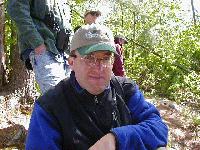
An Adirondack Weekend with the Federation of New York State Bird Clubs, 3 - 4 June 2000.
This is a summary of Kevin and Jay McGowan's experiences on the field trip set up by Bill Lee for the Federation of New York State Bird Clubs. All photos on this page were taken with an Olympus D-450 digital camera; all of the wildlife shots were taken through a Swarovski HD80 spotting scope. All photos were taken on this weekend, with the exception of the undertail coverts shot, which was taken later from a specimen at the Cornell University Museum of Vertebrates.
Because of the success of last year's Federation field trip to the Adirondacks, the turnout this year was large and enthusiastic. So many people wanted to go find Spruce Grouse, Bicknell's Thrush, and other Adirondack specialties that the group was split into two sections, with trips to Spring Pond Bog for Spruce Grouse and Whiteface Mountain for Bicknell's Thrush going each day.
Jay and I decided to start with the thrush, and arrived at the Four Seasons Motor Lodge in Wilmington, NY that Friday evening. The Four Seasons is located conveniently right at the road up to Whiteface, and the staff there were most congenial. (They even offered a special rate to the birders on the trip, which saved an appreciated $20.)

The trip met at 04:00 at the gate to Whiteface Mountain. Richard McDonald of the Nature Conservancy was the leader of this portion of the trip and had made arrangements to get us up the mountain before dawn.
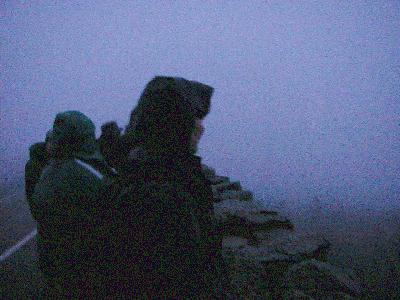 Despite the dark, cold, wind,
and rain, we were quickly rewarded by the beautiful songs of Bicknell's Thrushes (Catharus
bicknelli, formerly considered a subspecies of C. minimus, the Gray-cheeked
Thrush). Visibility, however, promised to remain limited even after the sunrise.
Despite the dark, cold, wind,
and rain, we were quickly rewarded by the beautiful songs of Bicknell's Thrushes (Catharus
bicknelli, formerly considered a subspecies of C. minimus, the Gray-cheeked
Thrush). Visibility, however, promised to remain limited even after the sunrise.
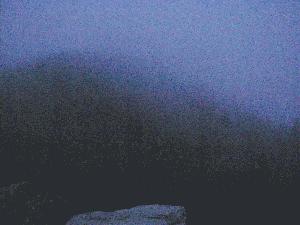
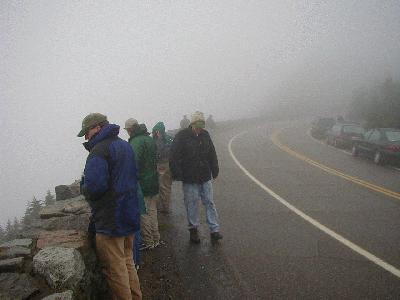
And it certainly stayed cold and windy even after we could see each other. (It took me a couple of minutes to figure out who the people were who had carpooled up there with me; and even after daylight some people stayed barely recognizable under their layers.)
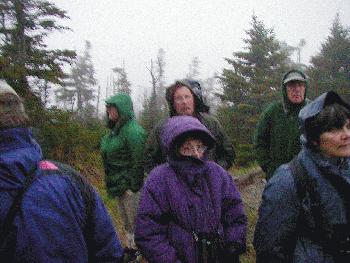
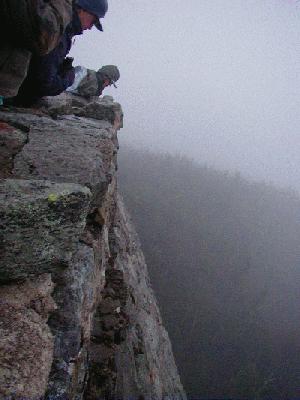
We had several male Bicknell's Thrushes singing near us, but they mostly stayed out of sight in the dense vegetation of balsam fir. Fortunately, we were able to get quick glimpses of one Bicknell's and one Swainson's thrush below us at the base of a rock wall. What few physical characters Bicknell's Thrush shows to distinguish it from Gray-cheeked, we saw (pale basal half of lower mandible; chestnut tones to tail). (I personally am unconvinced that the two species can be distinguished by sight alone.)
By 06:30 all of the thrushes had stopped singing, and we decided to leave.
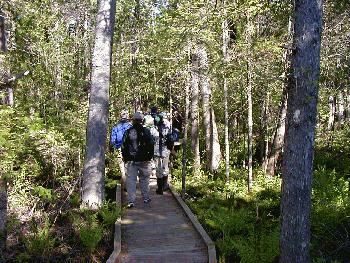
After a quick stop in Wilmington to get some coffee and get warmed up, we headed to Silver Lake Bog in Clinton Co. to check for Black-backed Woodpecker and
other boreal birds. This preserve, run by the Nature Conservancy, is a beautiful place,
with a great boardwalk through the bog. 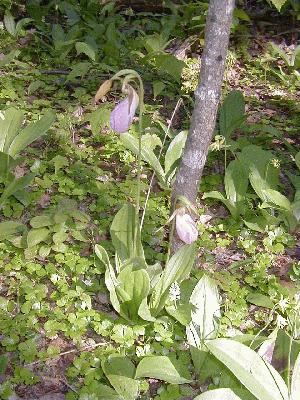
The nest of Black-backed Woodpecker from last year was lonely and unused this year, and no boreal woodpeckers were to be found.
\
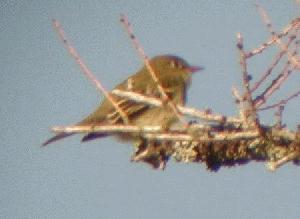 Still, we had a very nice walk
through the bog, getting good looks at Yellow-bellied Flycatcher and
Still, we had a very nice walk
through the bog, getting good looks at Yellow-bellied Flycatcher and
Olive-sided Flycatcher, 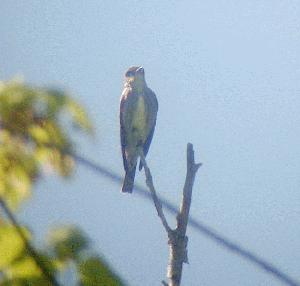
amongst the numerous Nashville and Magnolia Warblers.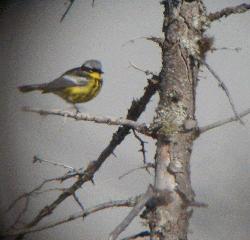
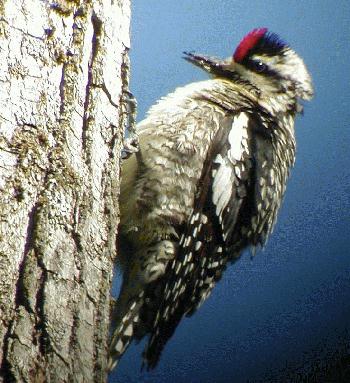
Also, we were able to confirm nesting of several species for the bog (for the NYS second Breeding Bird Atlas), based on their carrying food for nestlings, including Yellow-bellied Sapsucker (note the insect in bill), Brown Creeper, and Northern Waterthrush.
After Silver Lake Bog we all went our separate ways, most looking at various other bogs and places looking for the other "Adirondack specialties." Most were planning to meet again the next morning to look for Spruce Grouse.
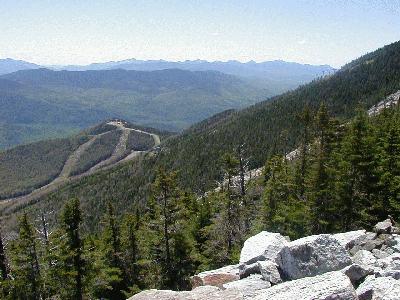 Jay and I chose to go back up
Whiteface to see the scenery, and who knows, maybe get a glimpse of another Bicknell's.
The scenery was fantastic, and definitely worth the trip up (compare this photo with the
third picture <above> taken in the same place in the morning).
Jay and I chose to go back up
Whiteface to see the scenery, and who knows, maybe get a glimpse of another Bicknell's.
The scenery was fantastic, and definitely worth the trip up (compare this photo with the
third picture <above> taken in the same place in the morning).
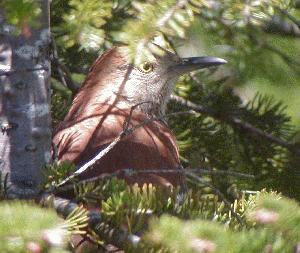
Although we heard the "flee-ur" notes of several Bicknell's Thrushes, we did not see any thrushes. The closest we got was a visual on a Brown Thrasher skulking in the firs at the Bicknell's spot.
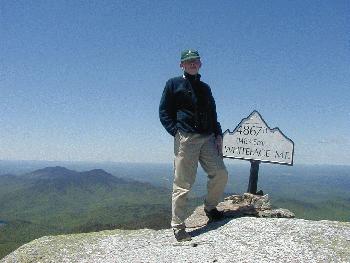
We enjoyed our time on the mountain, seeing the sights,
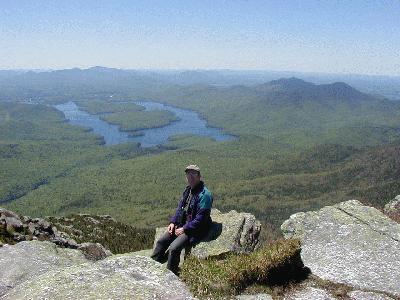
a number of Blackpoll and Yellow-rumped Warblers,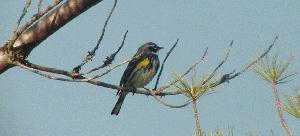 and a couple of Common Ravens.
and a couple of Common Ravens.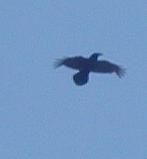
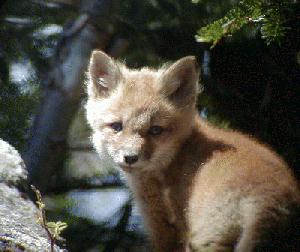
The best sighting on the way down was seeing a leather-clad motorcyclist stopping several other Harleys to took at the six red fox pups that were playing alongside the road.
From there Jay and I went to the trail along the Chubb River south of Lake Placid
village to look for Black-backed Woodpecker. We were slowly 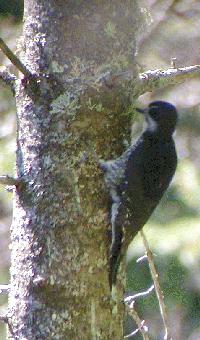 strolling along the trail, trying to get pictures of Blackburnian
and Nashville warblers, and as a consequence going even slower than usual. As good luck
would have it, while waiting for a teasing Nashville to pop out and get its picture taken,
we stumbled on a beautiful, and mostly cooperative male Black-backed Woodpecker.
strolling along the trail, trying to get pictures of Blackburnian
and Nashville warblers, and as a consequence going even slower than usual. As good luck
would have it, while waiting for a teasing Nashville to pop out and get its picture taken,
we stumbled on a beautiful, and mostly cooperative male Black-backed Woodpecker. 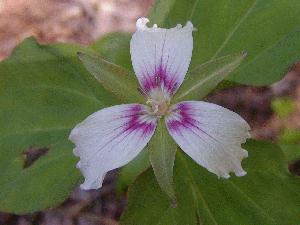 Other trip participants had been in the
same spot shortly before us, but, unfortunately, none were lucky enough to see the
woodpecker. (We never did get a picture of the Nashville, though.)
Other trip participants had been in the
same spot shortly before us, but, unfortunately, none were lucky enough to see the
woodpecker. (We never did get a picture of the Nashville, though.)
From there we stocked up with groceries in Saranac Lake, and headed to a public (and
free!) campground at Little Green Pond, directly adjacent to the
Adirondack Fish Hatchery where we were supposed to meet the next morning (thanks go to
Rich McDonald for telling us about it!). 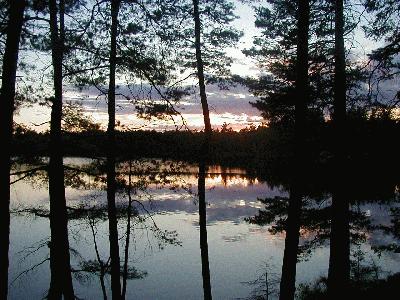
We quickly abandoned our first camp site choice to pick something a little farther away from the group of campers with the very loud music, even louder voices, and a very smoky fire. Fortunately we could get far enough away to spend an extremely pleasant evening (mosquitoes and no-see-um's notwithstanding). Next time we go camping and have soup for dinner, however, we plan to bring along a can opener and some spoons.
In the middle of the night we were awakened from our sound sleep several times by our noisy neighbors. This time, however, it wasn't the human neighbors, but rather the pair of Common Loons that were nesting on the pond. It was amazing how loud they were, and the variety of calls they made besides the standard yodel. They were even loud enough to wake up Jay, and that takes a lot of doing!
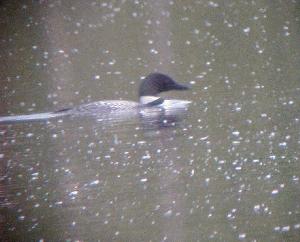
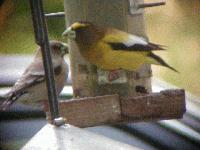 Bright and early the next morning
we met Bill Lee and John Ozard (of the DEC, Spruce Grouse expert) to head to Spring Pond
Bog to look for Spruce Grouse. While waiting for everyone to arrive, we were treated to
several Evening Grosbeaks at a nearby feeder.
Bright and early the next morning
we met Bill Lee and John Ozard (of the DEC, Spruce Grouse expert) to head to Spring Pond
Bog to look for Spruce Grouse. While waiting for everyone to arrive, we were treated to
several Evening Grosbeaks at a nearby feeder.
Spring Pond Bog was a great place, but, lordy was it buggy! John told us that we were going to have a great boreal experience, whether or not we found the grouse. You know when you meet your guide and he has on an industrial strength head net that you're in trouble. Fortunately for us, Jay and I had brought our own head nets. (Unfortunately, my scope pack kept pulling my shirt collar below the net!)
We had much better luck than the trip the previous day, and quickly encountered a
grouse. We heard it fly (it sounds kind of like distant thunder), but couldn't find it in
the dense trees. John found lots of Spruce Grouse scat and sign in the area, and we knew
the bird had to be nearby. We worked for a long time before moving on down the trail and
trying another spot. We got no response there, so decided to head to the second likely
location, keeping an eye out on our way. Once again we heard the grouse fly, and I even
got a glimpse of it (or at least some large, grouse-sized bird). Finally, while most of of
fanned out into the bog to look for the bird, the male Spruce Grouse was discovered in a
tree right next to the path. 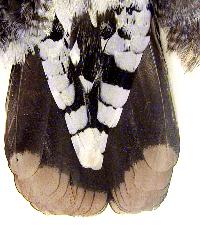 Three
quarters of the group got killer looks at it, at point blank range. Six of us, however,
were not so lucky. When I finally learned that the bird was in the closest spruce, I could
see its tail sticking out from the "wrong" side of the trunk to me (i.e., to the
right). I got my binoculars on it and had a great, quick look at the strikingly patterned undertail coverts (which are pretty diagnostic). I tried to grab Jay, who
was on my left and completely blocked by the tree trunk, to pull him to the right, but
before I could, the bird flew. Fortunately it flew left, and we got a fleeting look at the
small-headed, long-necked, dark grouse as it disappeared into the tangle of spruces. Not
much of a look, but two of our group didn't even get that (nor did the previous day's
participants). What a difference a few feet make!
Three
quarters of the group got killer looks at it, at point blank range. Six of us, however,
were not so lucky. When I finally learned that the bird was in the closest spruce, I could
see its tail sticking out from the "wrong" side of the trunk to me (i.e., to the
right). I got my binoculars on it and had a great, quick look at the strikingly patterned undertail coverts (which are pretty diagnostic). I tried to grab Jay, who
was on my left and completely blocked by the tree trunk, to pull him to the right, but
before I could, the bird flew. Fortunately it flew left, and we got a fleeting look at the
small-headed, long-necked, dark grouse as it disappeared into the tangle of spruces. Not
much of a look, but two of our group didn't even get that (nor did the previous day's
participants). What a difference a few feet make!
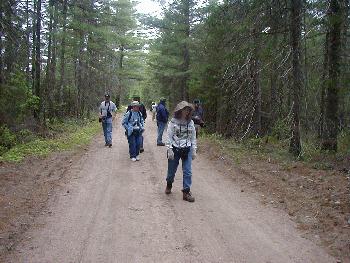 We tried a little while longer to
lure the bird in, but we had no luck. So, the subset of us who did not get good looks went
to Kildare Road to try another spot. We had a nearly immediate response (more distant
thunder of wings), and our hopes were high, but eventually the only thing that came near
us was a Gray Jay.
We tried a little while longer to
lure the bird in, but we had no luck. So, the subset of us who did not get good looks went
to Kildare Road to try another spot. We had a nearly immediate response (more distant
thunder of wings), and our hopes were high, but eventually the only thing that came near
us was a Gray Jay.
We saw more Spruce Grouse scat and a number of dusting spots along the road, but not the grouse.
Despite the major bugs and the slow finish, everyone had a great time. Many, many thanks go from all of us to Rich McDonald and John Ozard for leading the trips for the two specialties, and to Bill Lee for putting the whole trip together (despite his severe reactions to black fly bites he was out there in the thick of it all the time). I got two lifers out of the weekend, and Jay got three (a couple of others on the trip got even more). Also, we added a dozen or so species to our digital camera list and had a fun time in the woods. Something to write home about, it seems to me.
Kevin
All photos © Kevin J. McGowan
Return to the Bad Photos page.
Return to Kevin McGowan's Home Page.
Go to the Crow Page.